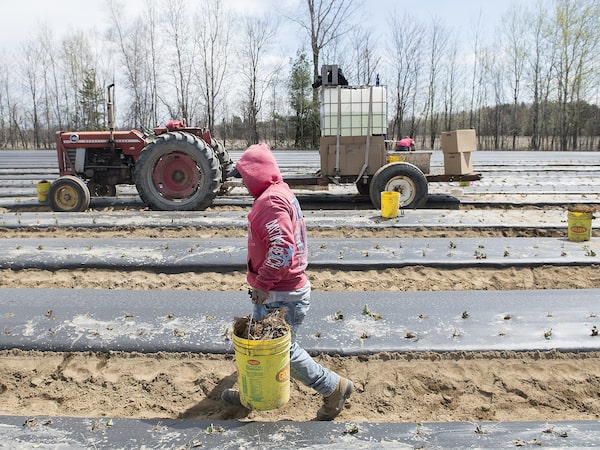
A temporary foreign worker from Mexico is shown on a berry farm in Mirabel, Que., Wednesday, May 6, 2020.Graham Hughes/The Canadian Press
Getting caught up on a week that got away? Here’s your weekly digest of the Globe’s most essential business and investing stories, with insights and analysis from the pros, stock tips, portfolio strategies and more.
Ottawa extends measure for hiring low-wage temporary foreign workers
Ottawa is extending a measure that allows Canadian companies in certain sectors to hire more of their staff at low wages through the Temporary Foreign Worker Program. According to Employment and Social Development Canada, employers in seven designated sectors “with demonstrated labour shortages” can continue to hire up to 30 per cent of their staff through the low-wage stream of the program. The temporary cap, which was set to expire on Oct. 30, now runs to Aug. 30, 2024, Matt Lundy reports. The seven sectors that benefit from the extension include accommodation and food services, construction, food manufacturing and hospitals.
Bank of Canada holds key interest rate steady at 5%
The Bank of Canada held its benchmark interest rate steady at 5 per cent on Wednesday in a widely anticipated decision, marking the second consecutive hold since July’s rate hike. But the central bank said inflationary risks have increased and it is leaving the door open to further increases, “if needed,” Mark Rendell reports. The good news is that higher borrowing costs are having their intended effect: Canadian consumers are pulling back on spending, unemployment is up and economic growth has slowed to a crawl. The bank has said, however, that it is not seeing the decline in house prices it had expected. The next interest rate decision – the last of the year – will happen on Dec. 6.
Steep price hikes are less widespread than before
Call it a minor victory for consumers, but rising prices are becoming less widespread across the economy. In its latest Monetary Policy Report, the Bank of Canada said price increases are still common, but “the breadth has narrowed considerably.” Matt Lundy reports that a wide variety of products are seeing more subdued price increases – or even declines. Over the past year, prices have risen 3 per cent for fresh fruit, 1.9 per cent for laundry detergent and 1.2 per cent for sports equipment. Prices have fallen 4.6 per cent for furniture and by 4.5 per cent for refrigerators and freezers. Take a closer look in this week’s Decoder.
St. Lawrence Seaway strike stalls road salt, wheat, steel cargo
For the second time this year, unionized workers at a key Canadian marine shipping route went on strike. More than 350 workers on the St. Lawrence Seaway walked off the job on Sunday after negotiators failed to reach an agreement with the St. Lawrence Seaway Management Corp., which operates 13 of the 15 Seaway locks between Montreal and Lake Erie, over wages. The work stoppage has halted shipments of road salt, Western wheat and steel products and other key commodities, and the St. Lawrence Seaway CEO tells Eric Atkins that he fears the strike will harm the waterway’s reputation. About 100 vessels were put at anchor on ports and harbours along the 3,700-kilometre system that connects the heart of North America with markets in Europe and Africa.
Condo buyers in Toronto luxury tower The One are stuck
Debt. Delays. Receivership status. Problems continue to plague Toronto’s luxury condo development The One after it was placed into receivership last week. Now, owners of condo units in the building are being told they cannot walk away with their deposits. They are only entitled to deposit refunds if Mizrahi Developments does not complete the skyscraper by January, 2028, Rachelle Younglai and Tim Kiladze report. Developers, however, are not allowed to charge the existing unitholders more money because of rising costs, a prohibition that is standard practice in the industry.
One-third of Canadian restaurants operating at a loss as costs rise
A third of Canadian restaurants – 34 per cent – are operating at a loss as of March, 2023, according to a new report from Restaurants Canada. Another 17 per cent said they were only breaking even. Why? Restaurateurs say they are facing increasing pressure on their bottom lines because of the rising costs of ingredients, insurance and wages. The aftershocks of the pandemic and inflation are causing an upheaval in the sector, Chris Hannay reports. As a result, restaurant owners are raising menu prices at record rates – but the pace that is still slower than their rising costs.
Now that you’re all caught up, test your knowledge with our weekly business and investing news quiz and prepare for the week ahead with the Globe’s investing calendar.

So you want to know how to succeed in Canada
Introducing the Newcomer's Guide to Finances in Canada, a straight-talking, five-part guide to money management for people new to the country. Sign up now – each lesson will land in your inbox on Wednesdays.
 Abigale Subdhan
Abigale Subdhan